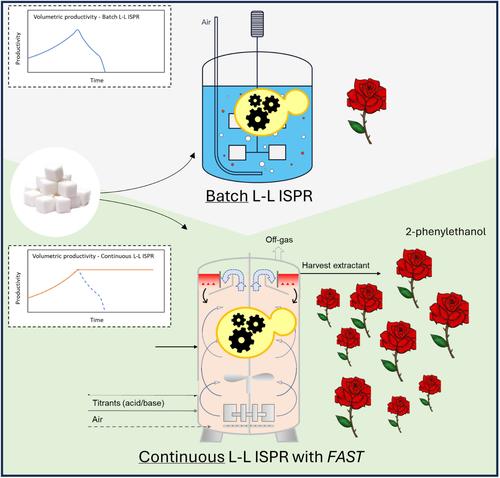Inhibition Control by Continuous Extractive Fermentation Enhances De Novo 2-Phenylethanol Production by Yeast
IF 3.5
2区 生物学
Q2 BIOTECHNOLOGY & APPLIED MICROBIOLOGY
引用次数: 0
Abstract
Current microbial cell factory methods for producing chemicals from renewable resources primarily rely on (fed-)batch production systems, leading to the accumulation of the desired product. Industrially relevant chemicals like 2-phenylethanol (2PE), a flavor and fragrance compound, can exhibit toxicity at low concentrations, inhibit the host activity, and negatively impact titer, rate, and yield. Batch liquid-liquid (L-L) In Situ Product Removal (ISPR) was employed to mitigate inhibition effects, but was not found sufficient for industrial-scale application. Here, we demonstrated that continuous selective L-L ISPR provides the solution for maintaining the productivity of de novo produced 2PE at an industrial pilot scale. A unique bioreactor concept called “Fermentation Accelerated by Separation Technology” (FAST) utilizes hydrostatic pressure differences to separate aqueous- and extractant streams within one unit operation, where both production and product extraction take place - allowing for the control of the concentration of the inhibiting compound. Controlled aqueous 2PE levels (0.43 ± 0.02 g kg−1) and extended production times (>100 h) were obtained and co-inhibiting by-product formation was reduced, resulting in a twofold increase of the final product output of batch L-L ISPR approaches. This study establishes that continuous selective L-L ISPR, enabled by FAST, can be applied for more economically viable production of inhibiting products.

连续萃取发酵的抑制控制提高了酵母的新 2-苯基乙醇产量
目前利用可再生资源生产化学品的微生物细胞工厂方法主要依赖于(喂养)批量生产系统,从而导致所需产品的积累。2-phenylethanol (2PE)(一种香精香料化合物)等与工业相关的化学品在低浓度时会表现出毒性,抑制宿主活性,并对滴度、速率和产量产生负面影响。批量液-液(L-L)原位产物去除(ISPR)技术可减轻抑制作用,但不足以满足工业规模的应用。在这里,我们证明了连续选择性液-液 ISPR 为在工业试验规模上保持从头生产 2PE 的生产率提供了解决方案。一种名为 "通过分离技术加速发酵"(FAST)的独特生物反应器概念利用静水压力差在一个单元操作中分离水流和萃取剂流,在此同时进行生产和产品萃取,从而控制抑制性化合物的浓度。通过控制 2PE 的水含量(0.43 ± 0.02 g kg-1)和延长生产时间(100 h),减少了共抑制副产品的形成,从而使批量 L-L ISPR 方法的最终产品产量提高了两倍。这项研究证明,利用 FAST 进行连续选择性 L-L ISPR,可以生产出更具经济效益的抑制性产品。
本文章由计算机程序翻译,如有差异,请以英文原文为准。
求助全文
约1分钟内获得全文
求助全文
来源期刊

Biotechnology and Bioengineering
工程技术-生物工程与应用微生物
CiteScore
7.90
自引率
5.30%
发文量
280
审稿时长
2.1 months
期刊介绍:
Biotechnology & Bioengineering publishes Perspectives, Articles, Reviews, Mini-Reviews, and Communications to the Editor that embrace all aspects of biotechnology. These include:
-Enzyme systems and their applications, including enzyme reactors, purification, and applied aspects of protein engineering
-Animal-cell biotechnology, including media development
-Applied aspects of cellular physiology, metabolism, and energetics
-Biocatalysis and applied enzymology, including enzyme reactors, protein engineering, and nanobiotechnology
-Biothermodynamics
-Biofuels, including biomass and renewable resource engineering
-Biomaterials, including delivery systems and materials for tissue engineering
-Bioprocess engineering, including kinetics and modeling of biological systems, transport phenomena in bioreactors, bioreactor design, monitoring, and control
-Biosensors and instrumentation
-Computational and systems biology, including bioinformatics and genomic/proteomic studies
-Environmental biotechnology, including biofilms, algal systems, and bioremediation
-Metabolic and cellular engineering
-Plant-cell biotechnology
-Spectroscopic and other analytical techniques for biotechnological applications
-Synthetic biology
-Tissue engineering, stem-cell bioengineering, regenerative medicine, gene therapy and delivery systems
The editors will consider papers for publication based on novelty, their immediate or future impact on biotechnological processes, and their contribution to the advancement of biochemical engineering science. Submission of papers dealing with routine aspects of bioprocessing, description of established equipment, and routine applications of established methodologies (e.g., control strategies, modeling, experimental methods) is discouraged. Theoretical papers will be judged based on the novelty of the approach and their potential impact, or on their novel capability to predict and elucidate experimental observations.
 求助内容:
求助内容: 应助结果提醒方式:
应助结果提醒方式:


